GALLUP NEWS SERVICE
PRINCETON, NJ -- The latest U.S. Census findings on the increasing diversity of America have received considerable attention this year. Americans seem to realize that the United States is a diverse nation, but recent polling suggests the public thinks the nation is more diverse than it actually is. Americans generally overestimate, to a significant degree, the percentage of the U.S. population that is either black or Hispanic. According to the U.S. Census Bureau, 12.3% of the U.S. population is black, and 12.5% is Hispanic. Gallup Poll results from March 26-28, however, show that slightly less than one in 10 Americans can accurately identify that the population of either blacks or Hispanics in this country falls between 10% and 14%. The typical American estimates the percentages of blacks and Hispanics in this country to be more than twice as high as they actually are.
On average, Americans say that 33% of the U.S. population is black. In fact, a majority of Americans (56%) estimate that the percentage of blacks in this country stands at 30% or higher. As many as 17% of Americans say the percentage of blacks is 50% or greater. Only 7% accurately state that the percentage of blacks falls between 10% and 14% of the entire population.
Americans' impressions about the percentage of Hispanics in this country are somewhat more accurate than their impressions about the percentage of blacks. Americans, on average, say that 29% of the U.S. population is Hispanic, which is slightly more than twice the actual percentage of Hispanics. About two in five Americans say Hispanics constitute 30% or more of the population. Just 10% accurately estimate that between 10% and 14% of the population is Hispanic.
Estimates of the Percentage of Hispanics Show Significant Change From 1990
There has been little change over the last decade in Americans' tendency to estimate the U.S. black population erroneously. According to the U.S. Census, in 1990, 12.1% of Americans were black. In a March 1990 Gallup poll -- taken while the 1990 census was being conducted -- the average American guessed that 32% of Americans were black. Fifty-one percent estimated that blacks made up 30% or more of the U.S. population, and only 8% correctly estimated that the percentage of blacks was between 10% and 14%. A 1997 Gallup poll produced similar results.
On the other hand, there has been some change in Americans' estimates of the Hispanic population in this country during the last 10 years. The U.S. Census Bureau shows that the percentage of Hispanics rose from 9% in 1990 to 12.5% in 2000. Gallup polling has shown a concomitant increase in Americans' estimates of the Hispanic population. The 1990 Gallup poll showed the average American guessing that 21% of Americans were Hispanic, compared to the 29% estimate of the average American today. In 1990, 41% of Americans guessed that Hispanics made up 20% or more of the population. Today, 65% think Hispanics represent at least 20% of the population, including 14% who think Hispanics constitute 50% or more of the population.
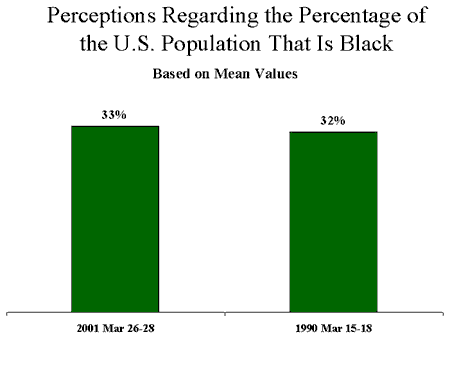
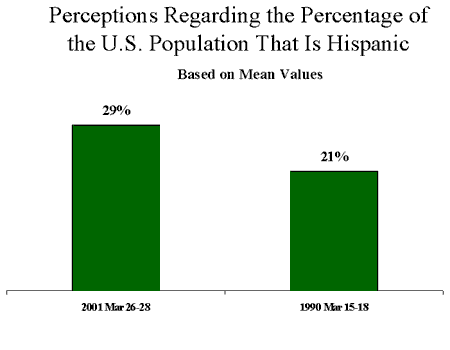

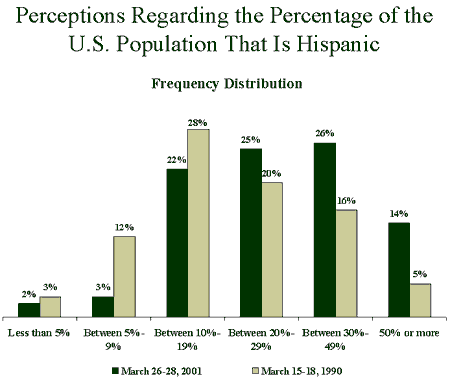
Lower-Income and Nonwhite Americans Most Likely to Overestimate U.S. Populations of Blacks and Hispanics
Perhaps because lower-income and nonwhite Americans are more likely to come into contact with blacks and Hispanics, these subgroups are most likely to overestimate the U.S. black and Hispanic populations. The average nonwhite estimates that 40% of the U.S. population is black and 35% of the population is Hispanic. Americans earning less than $20,000 estimate the black percentage of the U.S. population to be 42%, and the Hispanic percentage to comprise 37%. At the other end of the spectrum, adults earning at least $75,000 and adults with a college degree or postgraduate education are least likely to overestimate these populations.
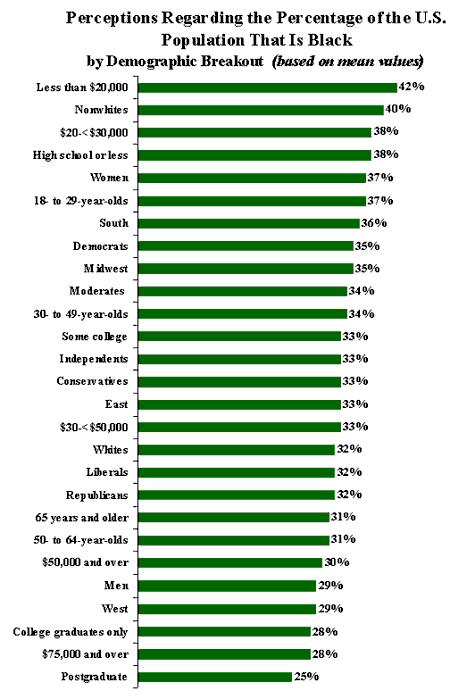
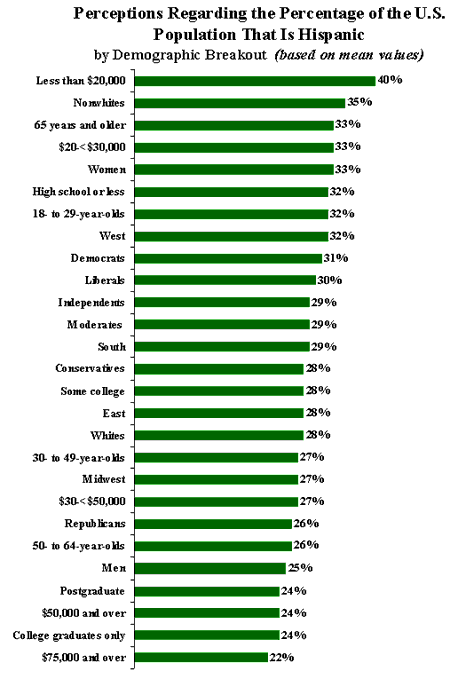
Survey Methods
The results reported here are based on telephone interviews with a randomly selected national sample of 1,024 adults, 18 years and older, conducted March 26-28, 2001. For results based on this sample, one can say with 95 percent confidence that the maximum error attributable to sampling and other random effects is plus or minus 3 percentage points. In addition to sampling error, question wording and practical difficulties in conducting surveys can introduce error or bias into the findings of public opinion polls.
NEXT TWO QUESTIONS ROTATED
Just your best guess, what percent of the United States population today would you say is black? [Open-ended and code actual number]
|
2001 Mar 26-28 |
1997 Jan 4-Feb 28 |
1990 Mar 15-18 |
|
|
% |
% |
% |
|
|
Less than 10% |
3 |
2 |
2 |
|
Between 10% and 14% |
7 |
8 |
8 |
|
Between 15% and 19% |
8 |
8 |
7 |
|
Between 20% and 29% |
19 |
15 |
21 |
|
Between 30% and 39% |
23 |
21 |
22 |
|
Between 40% and 49% |
16 |
16 |
16 |
|
50% or more |
17 |
17 |
13 |
|
No opinion |
7 |
13 |
11 |
|
Mean |
33 |
-- |
32 |
|
Median |
30 |
-- |
-- |
Just your best guess, what percent of the United States population today would you say is Hispanic? [Open-ended and code actual number]
|
2001 Mar 26-28 |
1990 Mar 15-18 |
|
|
% |
% |
|
|
Less than 5% |
2 |
3 |
|
Between 5% and 9% |
3 |
12 |
|
Between 10% and 19% |
22 |
28 |
|
Between 20% and 29% |
25 |
20 |
|
Between 30% and 49% |
26 |
16 |
|
50% or more |
14 |
5 |
|
No opinion |
8 |
16 |
|
Mean |
29 |
21 |
|
Median |
25 |
-- |
